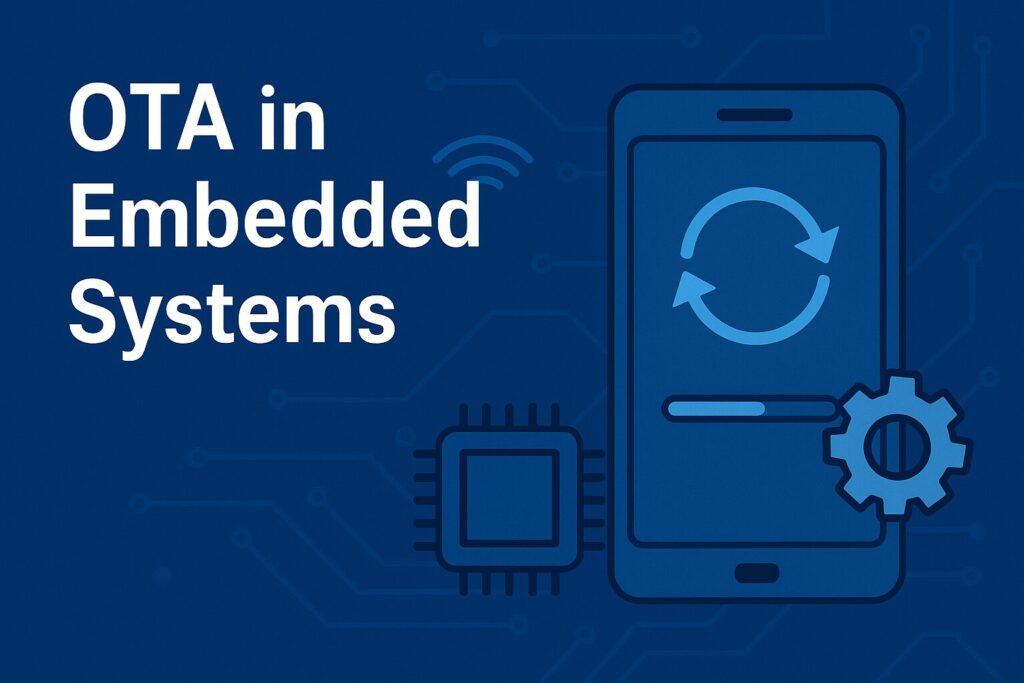OTA in Embedded Systems
Embedded systems are now present in nearly every area of our lives. From smart home devices to industrial machines, automotive electronics, and IoT solutions, these devices rely on embedded software to function. To remain efficient, secure, and up-to-date, they require regular software or firmware updates — and this is where OTA (Over-the-Air) comes in.
What is OTA?
OTA enables devices to have their software or firmware updated wirelessly and remotely. Unlike traditional methods that require a physical connection, OTA allows updates without moving or manually connecting the device. In simple terms, OTA lets you update the software directly on-site, without cables.
Importance of OTA in Embedded Systems
OTA updates provide significant benefits for both manufacturers and users:
- Cost savings: No need for service visits; updates are performed remotely.
- Time efficiency: Thousands of devices can be updated simultaneously.
- Security: Vulnerabilities can be patched quickly.
- User experience: Device performance improves, and bugs are fixed.
- Extended product life: Hardware remains unchanged, while software updates keep the device current.
How OTA Updates Work
A typical OTA process involves several steps:
- Update Check: The device regularly checks with a server for new firmware versions.
- Download: The firmware is securely stored in the device’s memory.
- Validation: Integrity checks ensure the file has not been tampered with.
- Writing: The new firmware is written to the designated flash memory.
- Restart: The device reboots with the updated software.
This process usually runs automatically in the background, with minimal or no user intervention.
Technologies Used for OTA
Depending on the device and application, various communication methods are used: Wi-Fi, Bluetooth Low Energy (BLE), GSM/4G/5G, and Ethernet.
Wi-Fi
- Pros: High bandwidth for large firmware files; uses existing home, office, or factory networks.
- Cons: Limited to Wi-Fi coverage; connection drops may cause issues.
Bluetooth Low Energy (BLE)
- Pros: Extremely low energy consumption; ideal for wearable devices like smartwatches or headphones.
- Cons: Limited speed and range (10–30 meters); large updates take longer.
GSM/4G/5G
- Pros: Available almost everywhere; ideal for IoT devices and automotive ECUs; 5G offers high speed and low latency.
- Cons: Requires a cellular plan, higher data costs, and increased energy consumption due to the radio module.
Ethernet
- Pros: Reliable, stable, uninterrupted connection; ideal for large firmware files in industrial setups.
- Cons: Wired connection; not suitable for portable devices.
Advantages of OTA Updates
OTA provides numerous benefits:
- Simplified maintenance
- Fast deployment
- Enhanced security
- Post-release feature expansion
- Improved user satisfaction
Challenges of OTA
Despite its advantages, OTA also presents challenges:
- Connection interruptions
- Increased power consumption
- Security risks if validation is not implemented
- Limited storage for multiple firmware versions
Robust security checks, integrity verification, and fault tolerance are therefore essential.
Future of OTA
As IoT devices proliferate, manual updates are no longer feasible. OTA is becoming the standard for maintaining device functionality. From automotive systems to healthcare devices, smart homes, and industrial automation, OTA ensures devices remain long-lasting, secure, and user-friendly.
Conclusion
OTA in embedded systems enables wireless, secure, and remote software updates. Manufacturers can quickly fix software issues, efficiently patch security vulnerabilities, and drastically reduce maintenance efforts. This not only saves costs but also enhances customer satisfaction, as devices stay continuously up-to-date without physical intervention.
For users, OTA provides a seamless experience: updates run automatically in the background, new features are delivered smoothly, and system security improves.
Additionally, OTA supports the long-term lifespan of embedded devices, allowing older hardware to meet current standards through software updates. In an increasingly connected world with billions of IoT devices, OTA is becoming a critical factor for efficiency, reliability, and flexibility. In the future, OTA will not just be a convenience but an essential feature to keep embedded systems secure, current, and high-performing.
🔗 Get in touch with us :
Phone/WhatsApp: +41 76 212 8248
✉️ E-Mail: info@revantechnology.com
For detailed information about our services in electronics development & PCB design:
Revan Technology – Your partner for professional electronics and PCB development
Discover our recent work:
Revan Technology – Our Projects


